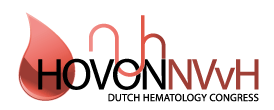iPSC-derived hematopoietic cells represent an adequate disease model to study anemia and therapeutic interventions in Diamond-Blackfan Anemia Syndrome
Diamond-Blackfan anemia syndrome (DBAS) is a rare inherited bone marrow failure syndrome characterized by hypoplastic anemia, congenital malformations and a predisposition to cancer. The majority of DBAS patients present with mutations in one of >20 ribosomal protein genes, and is both molecularly and clinically a very heterogeneous disorder. Treatment options for anemia in DBAS are limited and include glucocorticoids (GCs), red blood cell (RBC)-transfusions and allogeneic stem cell transplantation for a small selection of young patients. In addition to the evident need for novel therapeutic options, disease mechanisms driving anemia in DBAS are not yet completely elucidated and research is hampered by the scarce availability of patient samples and adequate disease models. The aim of our study is to develop iPSC-based models of DBAS representing different genotypes and clinical severity. These models can be used as a toolbox to study disease biology, response to GC and other candidate drugs for anemia.
We have generated iPSC-lines from DBAS patients with differential molecular defects and clinical severity. iPSC-lines were used to generate hematopoietic organoids (HeOs) from which RBC precursors were obtained. To functionally characterize DBAS iPSC-erythropoiesis and the in vitro response to GCs, iPSC-derived erythroblasts were harvested and the response to the GC analogue dexamethasone was followed during culture or upon acute stimulation. Assays included FACS analysis, qPCR for GC-target genes, total RNA-sequencing, morphological analysis and proliferation kinetics. MACS-sorted iPSC-derived erythroblasts allowed stage specific analysis when deemed appropriate.
We have generated DBAS patient-derived iPSC-lines with distinct molecular backgrounds (2x RPS19, 1x RPS26 & 1x unknown mutation). Using these lines, we successfully generated RBC-precursors from HeOs that represent the erythroid defect in DBAS, and match the clinical phenotypes of the respective DBAS patients and their response to GC-treatment in vivo. We also identify GILZ as GC-responsive gene and used it to determine the GC-receptor signaling kinetics in proerythroblasts. Together with proliferation kinetics and RNA-sequencing experiments, we used this to assess the response to GCs in our HeO-derived proerythroblasts. Currently, we are investigating genotype-phenotype correlations and the molecular mechanisms underlying the GC-response in our iPSC-models.
DBAS patient derived iPSC-lines can be used as novel disease model to study disease phenotypes in DBAS that are still poorly understood. In addition, iPSC-derived erythroblasts can be used to study “old and new” therapeutic interventions, including the widely used glucocorticoids. Our set of DBAS-iPSC lines represent a powerful toolbox for future DBAS studies that overcomes the need for additional patient material or animal models.

